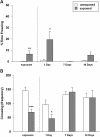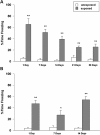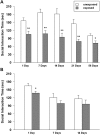An updated animal model capturing both the cognitive and emotional features of post-traumatic stress disorder (PTSD)
- PMID: 24808840
- PMCID: PMC4010768
- DOI: 10.3389/fnbeh.2014.00142
An updated animal model capturing both the cognitive and emotional features of post-traumatic stress disorder (PTSD)
Abstract
The new-released Diagnostic and Statistical Manual of Mental Disorders (DSM-5) defines post-traumatic stress disorder (PTSD) as a "trauma and stressor-related disorder". PTSD pathogenesis relies on paradoxical changes of emotional memory processing induced by the trauma exposure and associated with emotional dysfunction. Several animal models of PTSD have been validated and are currently used. Each one mimics a particular subset of the disorder with particular emphasis, mainly driven by the past classification of PTSD in the DSM-4, on the emotional features. In view of the recent update in the DSM-5, our aim was to develop, by using well-validated paradigms, a modified model of PTSD able to mimic at the same time both the cognitive and emotional features of the disease. We exposed male rats to either a piece of worn cat collar or to a series of inescapable footshocks paired with a PTSD risk factor, i.e., social isolation. Animals were subsequently re-exposed to the conditioned contexts at different time intervals in order to test memory retention for the stressors. In addition, footshock-exposed rats were tested in the elevated-plus-maze and social interaction tests. We found that rats exposed to a cat collar exhibited an acute fear response that did not lead to enduring memory retention. Conversely, footshock-exposed rats expressed a successful retention of the stressful experience at 1, 7, 14, 21 and 56 post-exposure days. Footshock-exposed rats displayed an anxious behavioral profile in the social interaction test and a significantly reduced locomotor activity in the elevated-plus-maze test. These dysfunctions were not observed when animals were socially housed, thus highlighting a social buffering effect in the development of the pathology. Our results underline the good validity of a footshock-based paradigm paired with social isolation as a PTSD animal model, able to mimic at the same time both some of the enduring cognitive and emotional facets of the pathology.
Keywords: animal models of PTSD; footshock; memory; predator odor; rats; social behavior; stress; trauma.
Figures





Similar articles
-
A behavioral screening method for predicting PTSD-like phenotypes: Novel application to female rats.J Neurosci Methods. 2025 Apr;416:110380. doi: 10.1016/j.jneumeth.2025.110380. Epub 2025 Jan 26. J Neurosci Methods. 2025. PMID: 39875080
-
Stress-induced enhancement of fear conditioning and sensitization facilitates extinction-resistant and habituation-resistant fear behaviors in a novel animal model of posttraumatic stress disorder.Physiol Behav. 2012 Jan 18;105(2):408-16. doi: 10.1016/j.physbeh.2011.08.037. Epub 2011 Sep 8. Physiol Behav. 2012. PMID: 21925525
-
[Posttraumatic stress disorder (PTSD) as a consequence of the interaction between an individual genetic susceptibility, a traumatogenic event and a social context].Encephale. 2012 Oct;38(5):373-80. doi: 10.1016/j.encep.2011.12.003. Epub 2012 Jan 24. Encephale. 2012. PMID: 23062450 Review. French.
-
Updates in PTSD Animal Models Characterization.Methods Mol Biol. 2019;2011:331-344. doi: 10.1007/978-1-4939-9554-7_19. Methods Mol Biol. 2019. PMID: 31273708 Review.
-
Amnesia for early life stress does not preclude the adult development of posttraumatic stress disorder symptoms in rats.Biol Psychiatry. 2014 Aug 15;76(4):306-14. doi: 10.1016/j.biopsych.2013.10.007. Epub 2013 Oct 12. Biol Psychiatry. 2014. PMID: 24231200 Free PMC article.
Cited by
-
Kaempferol Facilitated Extinction Learning in Contextual Fear Conditioned Rats via Inhibition of Fatty-Acid Amide Hydrolase.Molecules. 2020 Oct 14;25(20):4683. doi: 10.3390/molecules25204683. Molecules. 2020. PMID: 33066366 Free PMC article.
-
A novel arousal-based individual screening reveals susceptibility and resilience to PTSD-like phenotypes in mice.Neurobiol Stress. 2020 Dec 24;14:100286. doi: 10.1016/j.ynstr.2020.100286. eCollection 2021 May. Neurobiol Stress. 2020. PMID: 33392367 Free PMC article.
-
Emotional modulation of synapses, circuits and memory.Front Behav Neurosci. 2015 Feb 19;9:35. doi: 10.3389/fnbeh.2015.00035. eCollection 2015. Front Behav Neurosci. 2015. PMID: 25745390 Free PMC article. No abstract available.
-
Predicting susceptibility and resilience in an animal model of post-traumatic stress disorder (PTSD).Transl Psychiatry. 2020 Jul 21;10(1):243. doi: 10.1038/s41398-020-00929-9. Transl Psychiatry. 2020. PMID: 32694545 Free PMC article.
-
Mechanisms Underlying Footshock and Psychological Stress-Induced Abrupt Awakening From Posttraumatic "Nightmares".Int J Neuropsychopharmacol. 2016 Apr 20;19(4):pyv113. doi: 10.1093/ijnp/pyv113. Print 2016 Apr. Int J Neuropsychopharmacol. 2016. PMID: 26591007 Free PMC article.
References
-
- American Psychiatric Association. (2013). Diagnostic and Statistical Manual of Mental Disorders DSM-5 Fifth Edition. Washington, DC: American Psychiatric Publishing
LinkOut - more resources
Full Text Sources
Other Literature Sources
Miscellaneous

